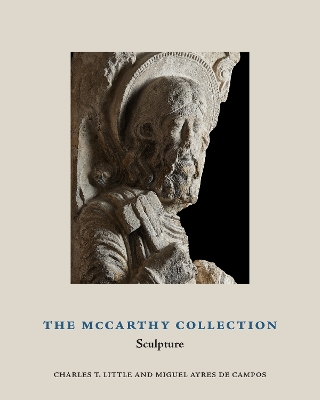The McCarthy Collection
1 total work
This substantial catalogue explores a remarkable collection of medieval European sculpture. Richly detailed with plentiful illustrations and original research, it is a notable contribution to medieval scholarship.
The McCarthy collection comprises more than 150 specimens of medieval European sculpture, produced over a period of nearly 600 years. A testimony to the comprehensiveness of Robert McCarthy’s interest in the art and culture of the Middle Ages, its geographical, chronological and typological breadth place it among the most important of its kind in private hands.
Including a few early examples from Merovingian France, Anglo-Saxon England and Visigothic Spain, its holdings have a strong focus on Romanesque art, with over fifty capitals and other architectural carvings from Iberia, France and the Italian Peninsula. Some of these pieces are associable with such notable workshops as those of Gislebertus, the Master of Agüero and Compostela’s Master Mateo, while a great number can be closely compared to anonymous works in major and provincial sites. Notable monuments like the monastic powerhouse of Cluny or the abbatial churches of Autun and Savigny are represented through important sculptural fragments — most published here for the first time.
The transition to the Gothic style and the period of its splendour, particularly in France, are witnessed by an ample selection of statuary and architectural fragments — some traceable to such important buildings as Noyon cathedral and Paris’ Notre Dame, and others, more loosely, to the artistic circles that gravitated around the great projects of the age. Freestanding sculpture in stone or wood, including a small but precious nucleus of Virgin and Child statuary and some Spanish polychrome figures, constitutes an interesting subset of the collection’s late medieval holdings, as do some especially fine examples of Italian trecento sculpture.
Enriched with outstanding photography by Barney Hindle and Mark French, entries aim to provide detailed stylistic, iconographic and contextual analyses, with special attention paid to comparanda in public and other private collections. This approach, complemented in some cases by petrographic analysis, has allowed the authors to connect much of the material presented in these pages with specific buildings, workshops or regional schools, contributing to a better understanding of the pieces themselves, their original settings and their cultural and artistic milieux.
This catalogue follows the publication of three volumes dedicated to Robert McCarthy’s vast collection of Western miniatures and manuscript leaves (2018-2021), and is part of an ambitious project to document the entirety of his holdings — which also include notable selections of medieval ivories, stained glass and East Christian Art.
The McCarthy collection comprises more than 150 specimens of medieval European sculpture, produced over a period of nearly 600 years. A testimony to the comprehensiveness of Robert McCarthy’s interest in the art and culture of the Middle Ages, its geographical, chronological and typological breadth place it among the most important of its kind in private hands.
Including a few early examples from Merovingian France, Anglo-Saxon England and Visigothic Spain, its holdings have a strong focus on Romanesque art, with over fifty capitals and other architectural carvings from Iberia, France and the Italian Peninsula. Some of these pieces are associable with such notable workshops as those of Gislebertus, the Master of Agüero and Compostela’s Master Mateo, while a great number can be closely compared to anonymous works in major and provincial sites. Notable monuments like the monastic powerhouse of Cluny or the abbatial churches of Autun and Savigny are represented through important sculptural fragments — most published here for the first time.
The transition to the Gothic style and the period of its splendour, particularly in France, are witnessed by an ample selection of statuary and architectural fragments — some traceable to such important buildings as Noyon cathedral and Paris’ Notre Dame, and others, more loosely, to the artistic circles that gravitated around the great projects of the age. Freestanding sculpture in stone or wood, including a small but precious nucleus of Virgin and Child statuary and some Spanish polychrome figures, constitutes an interesting subset of the collection’s late medieval holdings, as do some especially fine examples of Italian trecento sculpture.
Enriched with outstanding photography by Barney Hindle and Mark French, entries aim to provide detailed stylistic, iconographic and contextual analyses, with special attention paid to comparanda in public and other private collections. This approach, complemented in some cases by petrographic analysis, has allowed the authors to connect much of the material presented in these pages with specific buildings, workshops or regional schools, contributing to a better understanding of the pieces themselves, their original settings and their cultural and artistic milieux.
This catalogue follows the publication of three volumes dedicated to Robert McCarthy’s vast collection of Western miniatures and manuscript leaves (2018-2021), and is part of an ambitious project to document the entirety of his holdings — which also include notable selections of medieval ivories, stained glass and East Christian Art.
